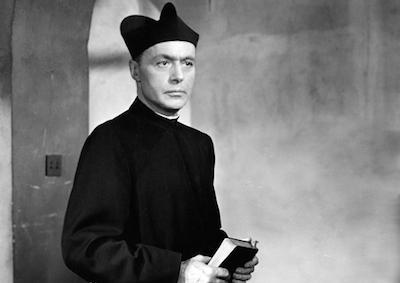All is not well in the hushed spaces of Jesuit Saint Gregory’s Seminary. Dominated by conservative older men, the institution is sometimes suffocating to younger initiates such as Father John Fulton (Wesley Addy), whose spirituality is stimulated more by music concerts outside of the walls than by prayer and study within. Even a seasoned professional like Father Arnoux (Charles Boyer), a former lawyer and writer of searching, philosophical articles, chafes within the small community of leaders who resist introspection and change, and obsess over seeing their founding figure, “Blessed Joseph,” canonized by the Roman church. Salty Monsignor Carey (William Demarest) from the local Catholic parish is a frequent, friendly scold: admiring the Jesuits’ mission work and determination, while needling them for their backwardness.
A new wind blasts through the stalwart institution when aged Father Sierra (H. B. Warner), who has been bedridden and failing for several years, stands and walks after envisioning Blessed Joseph. Suddenly, all are animated by the apparent presence of a miracle—from young priests who have sought a sense of spiritual meaning, to older ones who see an opportunity to advance the cause of canonization. The public is likewise energized, as pilgrims flock to the lure of healing power. All of this is to the great chagrin of Doctor Peter Morell (Lyle Bettger), who treated Father Sierra and looks upon the topic of “miracles” with derision. He is especially sorry to see his young friend Terry Gilmartin (Barbara Rush), a socialite crippled in a riding accident, joining the pilgrims. Morell’s disgust moves him to confide to Father Arnoux that things are not as they seem in Father Sierra’s recovery—threatening the hopes of thousands, including those of the small religious community.
Trafficking in the parochial concerns of a complex subculture, director Douglas Sirk evokes powerful, universal emotions with this fascinating independent production, completed before his celebrated, decade-long run as a director of melodramas at Universal Pictures. Here, the question of openings and dead ends that occur in both scientific pursuits and faith journeys is made remarkably compelling, and all the more fascinating as enacted by a sterling cast headed by Boyer and Bettger—each man seeking a way to live a principled life that accommodates both common sense and hope. —Shannon Kelley
Director: Douglas Sirk. Production: Sedif Pictures Corp. Distribution: United Artists Corp. Producer: Douglas Sirk. Screenwriter: Emmet Lavery. Based on the play The First Legion by Emmet Lavery. Cinematographer: Robert de Grasse. Music: Hans Sommer. Cast: Charles Boyer, William Demarest, Lyle Bettger, Barbara Rush, Leo G. Carroll. 35mm, b/w, 86 min.
Restored from a 35mm acetate fine grain master and two 35mm acetate prints. Laboratory services by Fotokem, Film Technology Company, Chace Audio by Deluxe. Special thanks to: Tracy Lavery.






 Mobile Navigation
Mobile Navigation

